Overview:
The article addresses common null issues in Power BI and provides solutions for effectively managing these challenges to enhance data integrity and reporting accuracy. It emphasizes the importance of recognizing, addressing, and preventing null values through various strategies, such as using DAX functions, implementing information entry standards, and fostering cross-functional collaboration, which collectively ensure reliable insights for informed decision-making.
Introduction
In the realm of data analytics, the presence of null values can pose significant challenges, often leading to skewed insights and compromised decision-making. As organizations increasingly rely on Power BI for their reporting needs, understanding and effectively managing these null values becomes paramount.
With the upcoming updates and innovative strategies at their disposal, businesses can enhance data integrity and operational efficiency. From practical solutions like replacing and filtering nulls to leveraging AI for predictive analytics, this article delves into actionable techniques that empower organizations to tackle null value issues head-on.
By adopting these best practices, companies can not only improve their data quality but also foster a culture of informed decision-making that drives growth and innovation.
Understanding Null Values in Power BI
In Power BI, power bi null entries signify the lack of information within a specific field and can arise from various sources, including incomplete record entries, errors during information import, or specific filtering conditions. Comprehending these power bi null entries is crucial, as they greatly affect computations, visual representations, and the overall quality of your information. For example, unprocessed empty entries can result in deceptive outcomes during aggregations, compromising the trustworthiness of your analysis.
With the forthcoming January 2025 Power BI update, new features are designed to improve techniques for handling power bi null values, further ensuring information integrity and operational effectiveness.
A practical illustration of how missing entries affect decision-making is shown in the case study titled ‘Order Shipment Analysis.’ This analysis revealed that orders were most likely shipped out on Tuesdays, despite the expectation that they should be shipped on Mondays. Such insights are essential for improved planning and resource distribution, highlighting the significance of tackling absent entries in your BI strategy.
As reiterated by a regular attendee, Sahar_lt, “I want to display the count of missing entries for all features in a single visual. I unpivoted the table in Power Query Editor, created measures to calculate blank and total figures, and visualized them in a Stacked Column Chart. This method demonstrates the importance of recognizing and handling missing entries, such as power bi null values, to ensure precise information representation and analysis within Power BI.
Moreover, RPA solutions can simplify the process of recognizing and handling these missing values, improving information integrity and operational efficiency. By effectively addressing these challenges, you enhance the integrity of your reports and empower stakeholders to make informed decisions based on trustworthy information, optimizing growth and innovation in your organization.
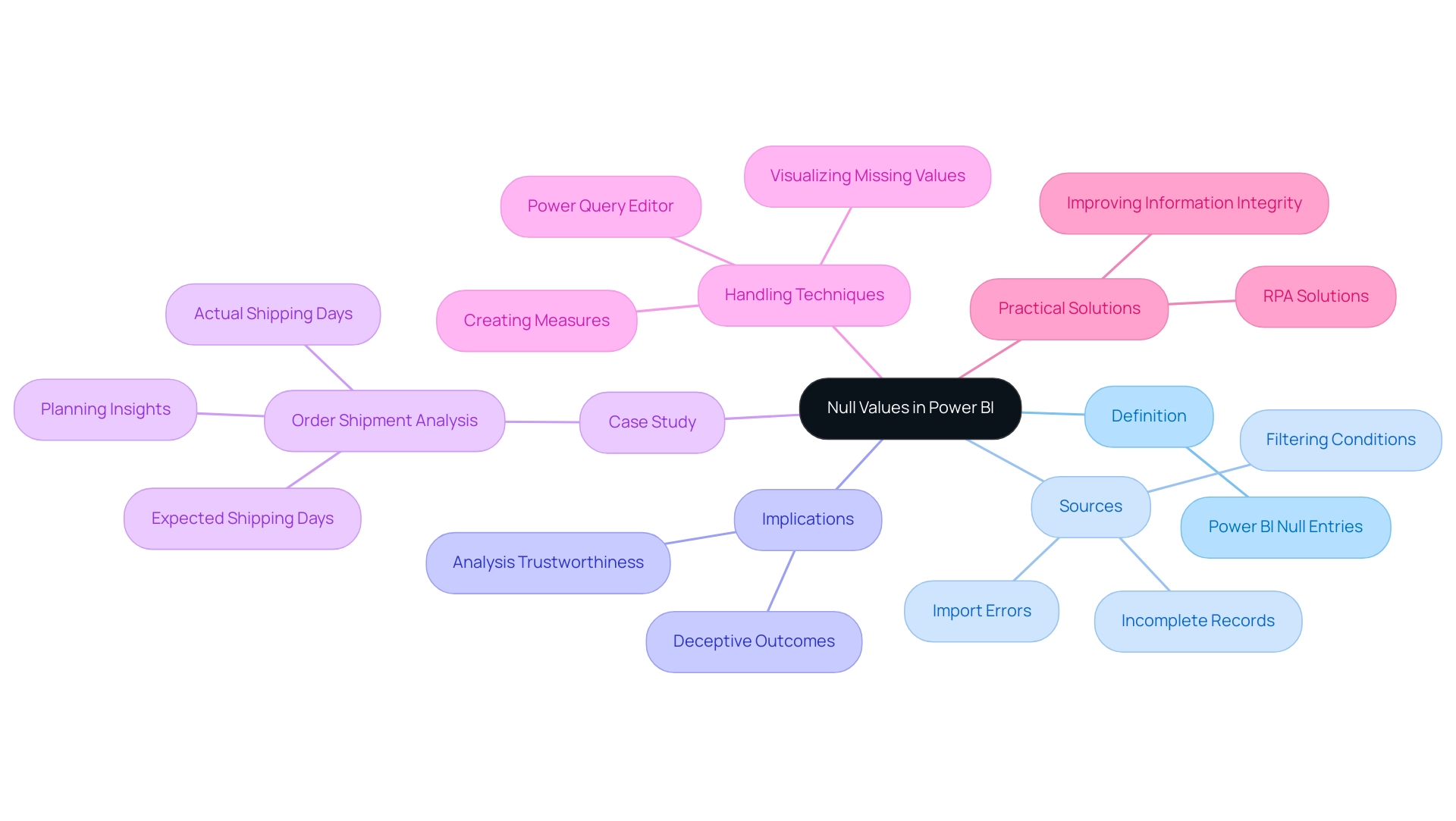
Common Solutions for Power BI Null Issues
Tackling Power BI null issues is crucial for attaining precise insights and reporting, especially when dealing with the frequent challenges of time-consuming report creation and inconsistencies due to a lack of governance strategy. Here are some effective solutions that empower users to manage empty values proficiently:
- Replace Missing Values: Utilize the ‘Replace Values’ feature in Power Query to substitute missing entries with a calculated average or a meaningful placeholder, such as 3 or 4 in the provided sample set. This method not only maintains continuity in datasets but also ensures that users are working with pertinent figures, enhancing integrity and reducing report discrepancies.
- Filter Out Empty Values: Use filtering techniques in Power BI to exclude empty entries from visuals or calculations. By doing so, your analysis concentrates exclusively on complete entries, enhancing the integrity of your reports and ensuring stakeholders receive clear, actionable insights.
- Conditional Columns: Create conditional columns in Power Query that categorize or modify empty entries based on specific criteria. This approach allows for a more nuanced handling of information, enabling users to tailor their datasets effectively while providing clearer guidance on next steps.
- DAX Functions: Utilize DAX functions like
IF,ISBLANK, andCOALESCEto dynamically handle empty entries in calculations. This guarantees that empty values do not distort your findings, offering a clearer representation of your information and aiding in informed decision-making. - Information Verification: Establish strong information verification guidelines within your source systems to prevent empty entries from entering your datasets. This proactive measure enhances data quality from the outset, leading to more reliable analytics and reducing the burden of report creation.
- Merge Queries: When combining queries, pay close attention to how empty entries interact. Constructing your join conditions to account for missing values can prevent unexpected outcomes, ensuring precision in combined datasets and fostering trust in your reporting.
- Use Visual Indicators: Utilize Power BI’s visual indicators to emphasize or mark missing entries in reports. This feature simplifies the process for users to recognize and resolve these problems quickly, promoting a culture of information integrity and operational efficiency.
By utilizing these approaches, Power BI users can effectively handle Power BI null values, greatly enhancing the precision of the analysis and reporting. These practices not only enhance information integrity but also contribute to operational efficiency by ensuring that stakeholders have access to reliable insights. As a recent case study demonstrates, users who calculated averages by category instead of relying on overall averages found that their insights were not only clearer but also actionable.
Furthermore, with a course rating of 4.8 on Building LLM Applications using Prompt Engineering, the effectiveness of these solutions is well-supported. Ultimately, these practices result in a more informed decision-making process, with expert opinions confirming that a comprehensive method to absent data is essential in today’s data-driven environment. As noted, ‘Orders were most likely to ship out on Tuesday,’ emphasizing the importance of timely and precise information handling in achieving operational efficiency.
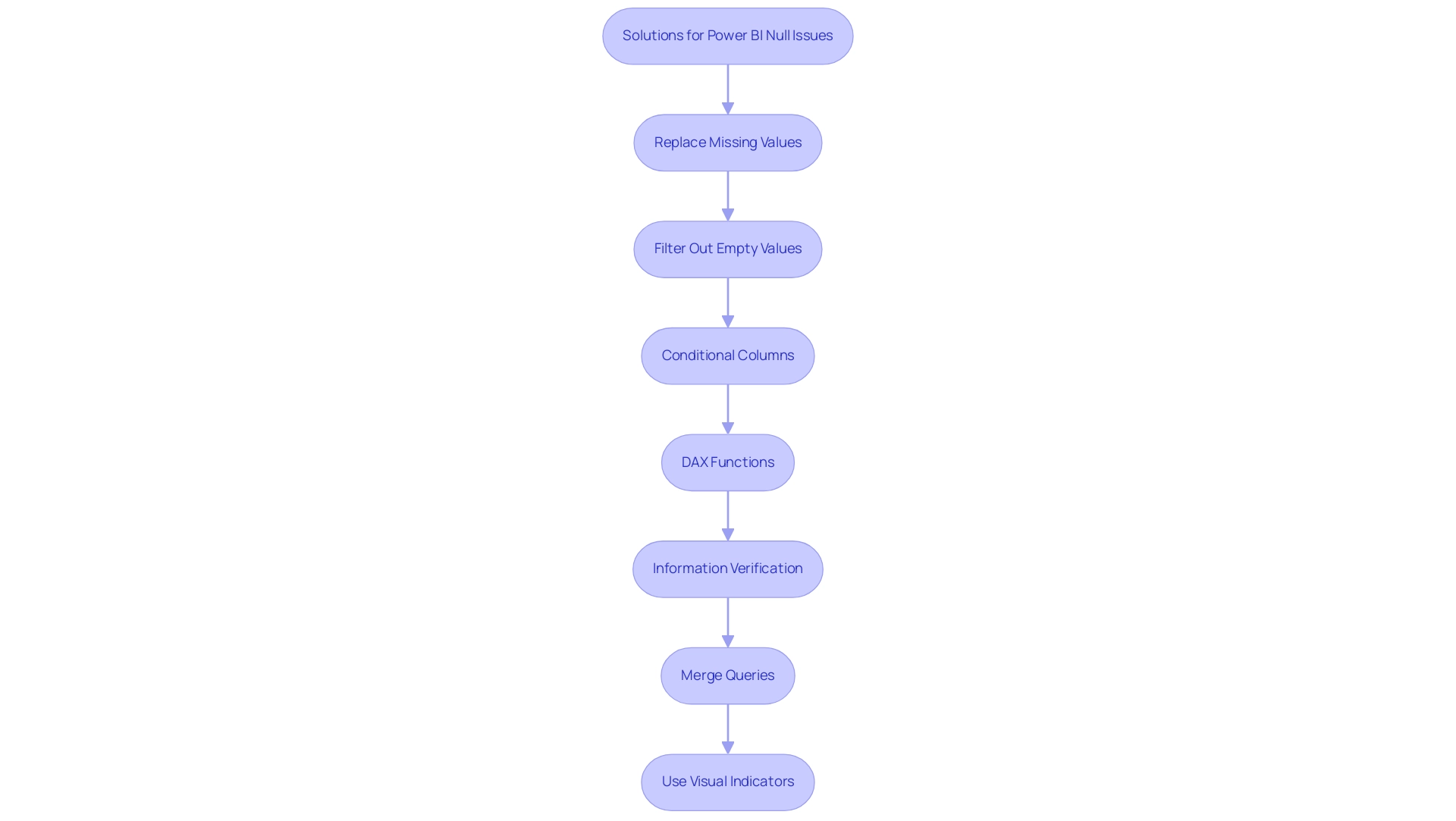
Best Practices for Preventing Null Values
To protect your Power BI reports from the negative impacts of null values and improve overall information standards, consider implementing the following best practices:
-
Information Entry Standards: Establishing clearly defined information entry standards is essential for minimizing incomplete submissions and ensuring that information is collected consistently and accurately. This step is crucial in addressing the challenges of subpar master information, which can impede operational efficiency and result in inconsistent, incomplete, or flawed information.
-
Regular Information Audits: Conducting frequent information audits is crucial for identifying and rectifying Power BI null values before they can distort your reports. This proactive method not only improves your information standards but also aids informed decision-making that fosters growth and innovation, tackling the obstacles organizations encounter when embracing AI.
-
Training and Awareness: Equip your team with training on the importance of information quality. Nasima Tamboli, a Freelance Software Engineer and Data Science Enthusiast, advises,
Identify missing information type: MCAR, MAR, or MNAR.
Comprehending these classifications assists your team in identifying the nature of absent information, allowing them to apply suitable strategies for mitigation and promoting an evidence-based culture that is vital for successful AI integration. -
Automated Information Quality Checks: Incorporating automated verifications within your information pipelines can assist in identifying or rectifying absent entries as they occur, enhancing your information management procedure. This aligns with the implementation of RPA tools, which can significantly improve operational efficiency by automating repetitive tasks, thus addressing the concerns regarding the time-intensive nature of AI projects.
-
Source System Controls: Work together with source systems to implement measures that avoid the creation of empty entries during information gathering. Implementing constraints and default settings can uphold information integrity from the outset, as illustrated in the case study titled Using Default Settings and Constraints, which successfully reduced incomplete submissions.
By adopting these strategies, organizations can significantly diminish the prevalence of null entries in Power BI, leading to more reliable and accurate reporting in Power BI. Furthermore, strict information integrity standards are essential since incomplete information can result in mistakes, distortions, or biases in your analysis, thus creating obstacles to effective AI adoption and diminishing the importance of Business Intelligence initiatives. Enhancing information quality through these practices not only boosts reporting accuracy but also aids the successful integration of AI technologies, addressing the concerns organizations may have.
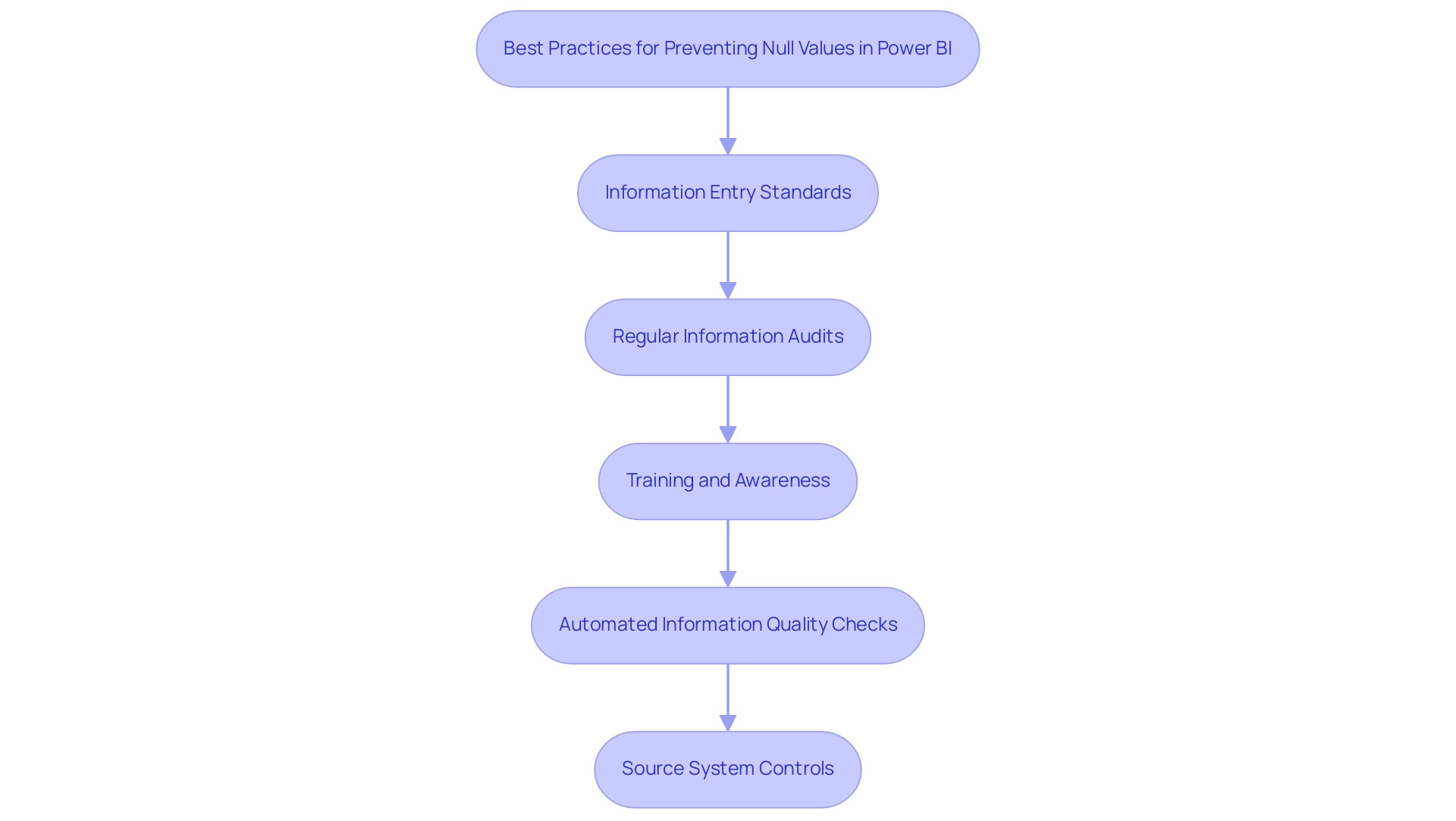
Leveraging AI for Enhanced Data Insights
Artificial intelligence is transforming the manner in which organizations improve insights and address Power BI null values. Here are several impactful strategies to leverage AI effectively:
- Predictive Analytics: Harness AI-driven predictive analytics to uncover patterns and anticipate potential null occurrences.
For instance, a retail business utilizes Power BI predictive analytics to forecast seasonal sales by analyzing sales history, customer trends, and weather conditions. This proactive approach enables teams to implement preventive measures before information quality is compromised.
- Data Enrichment: AI technologies, including Small Language Models, can significantly enhance datasets by intelligently filling gaps or proposing options based on historical trends.
The Tag Images feature, which identifies over 2,000 objects, demonstrates how AI can improve information enrichment, reducing the negative impacts of missing entries and enhancing overall quality.
-
Automated Information Integrity Monitoring: Implement AI tools that provide continuous oversight of information accuracy, instantly flagging Power BI null values and other anomalies for rapid resolution. This real-time oversight ensures that information remains reliable and actionable, essential for informed decision-making in a fast-paced environment.
-
Natural Language Processing (NLP): Utilize NLP to explore user feedback or remarks concerning information integrity challenges. This examination can provide insights into particular areas where absent entries remain, guiding focused interventions and improving operational efficiency.
-
GenAI Workshops: Participate in GenAI Workshops to educate your teams on effectively using AI tools for information management, ensuring they are prepared to manage absent entries and enhance information integrity through practical applications.
A pertinent case study is the Pharma HCP Portal, which demonstrates the successful application of AI to improve communication and resource sharing with healthcare professionals. By incorporating AI into information management systems, organizations not only tackle empty field challenges more skillfully but also improve overall quality and enhance decision-making processes.
Additionally, it’s crucial to acknowledge potential challenges in AI implementation, such as integration with existing systems and user adaptation, which can be mitigated through tailored solutions and ongoing support.
Embracing these advancements positions teams to be more agile and responsive in today’s data-driven landscape.
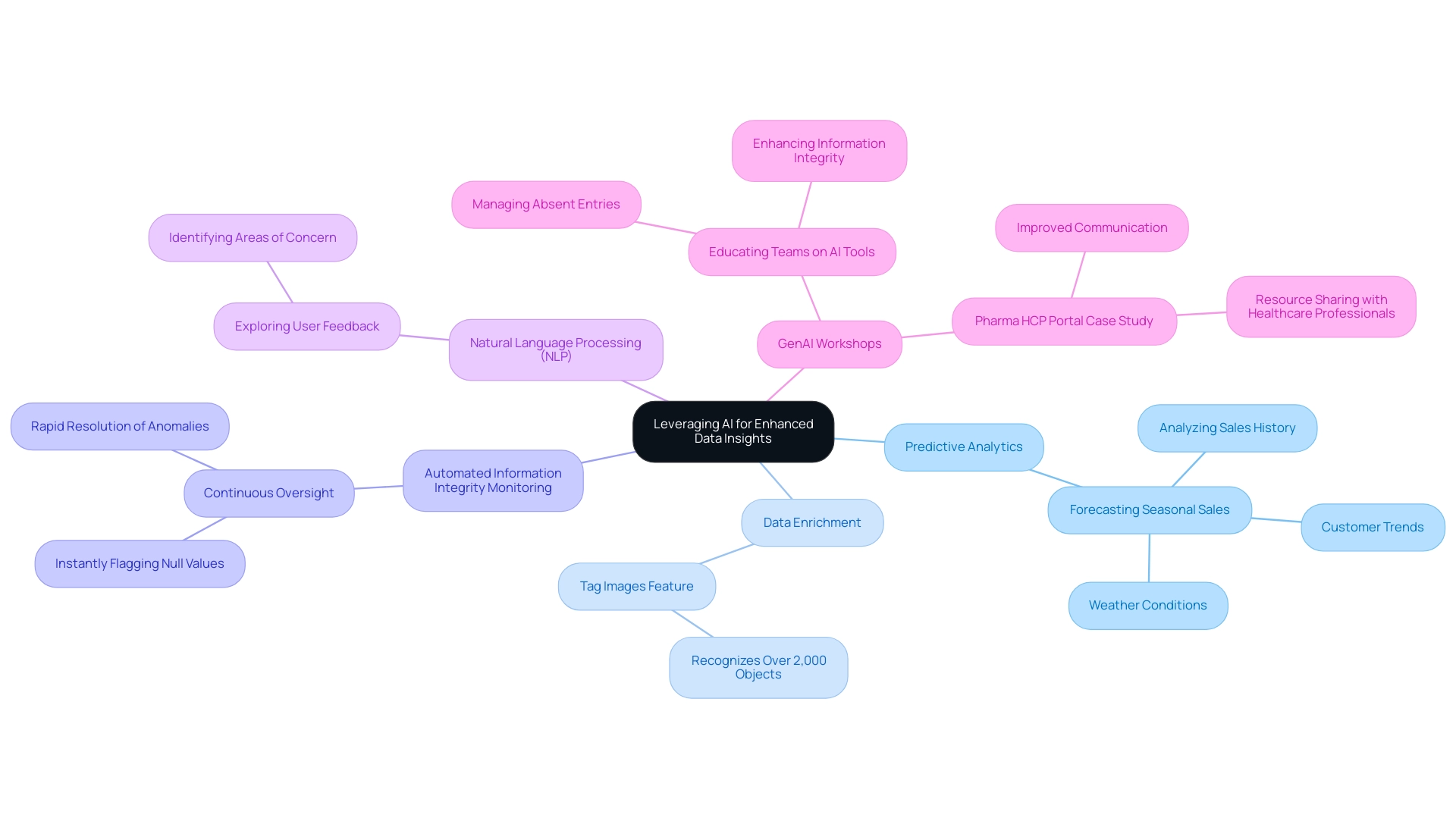
Collaborative Approaches to Data Management
Effective information management, particularly in addressing the challenges posed by power bi null and blank values, is heavily reliant on collaboration across various departments. At Creatum GmbH, we believe that designing transformative solutions requires a commitment to collaboration, creativity, and excellence. Here are some empowering strategies to cultivate teamwork:
-
Cross-Functional Teams: Assemble cross-functional teams that consist of members from information entry, analytics, and IT. This varied partnership guarantees a comprehensive method for addressing information issues, utilizing the distinct viewpoints that promote creative solutions.
-
Common Objectives and Measurements: Create collective aims and measurements centered on information accuracy. When all teams align towards common goals, it nurtures a culture of collective responsibility, which enhances accountability and fosters collaboration.
-
Regular Communication: Implement a schedule for regular meetings dedicated to discussing information quality challenges. These sessions allow teams to share insights, align strategies, and establish best practices for effectively managing power bi null values.
-
Feedback Loops: Introduce feedback loops where teams can communicate their experiences with information quality—both challenges and successes. This continuous dialogue fosters an environment of ongoing improvement and responsiveness.
A case study exemplifying this is Zight, which facilitates training and onboarding by allowing for the storage and sharing of training materials and the creation of onboarding checklists. This guarantees that new team members can easily access essential information, fostering effective collaboration and enhancing information management practices.
Furthermore, research shows that 86% of employees and executives link workplace failures to a lack of collaboration or ineffective communication. Organizations experiencing high collaboration drag are 37% less likely to meet revenue and profit goals, underscoring the critical nature of effective collaboration. By adopting a collaborative framework, organizations can significantly improve their information management practices.
This not only improves the handling of power bi null values but also elevates overall information quality, leading to better decision-making and operational efficiency.
As Mohsen Rezaei Hemami, a health economist, suggests, ‘Effective collaboration is not just a strategy; it’s a necessity for organizational success.’ This highlights the importance of integrating collaborative approaches into data management, which is at the heart of Creatum’s mission and our commitment to excellence.
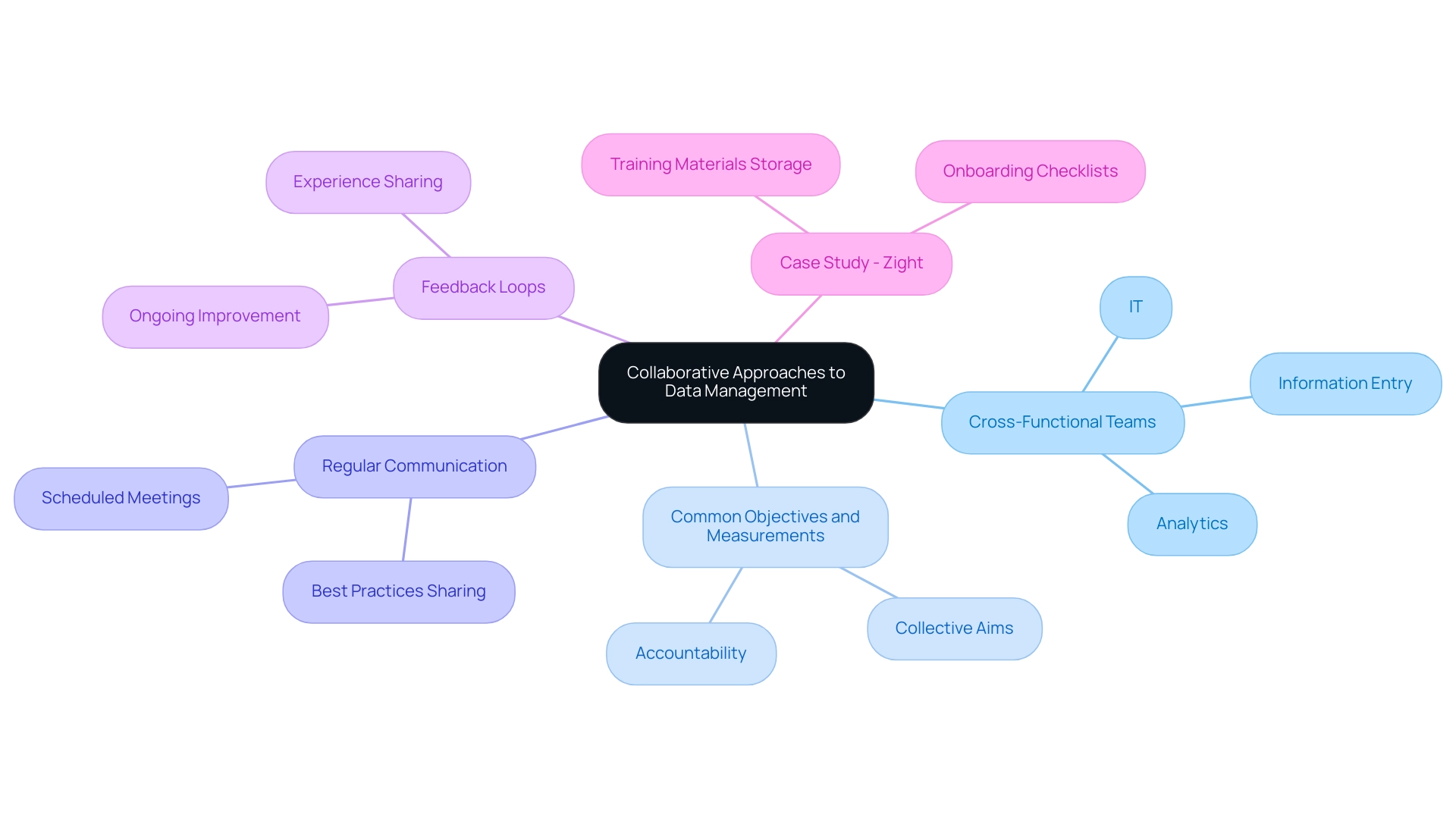
Conclusion
Addressing null values in Power BI is crucial for organizations striving to maintain data integrity and ensure reliable reporting. By understanding the origins and implications of these null values, businesses can implement effective strategies that not only mitigate their impact but also enhance the overall quality of insights derived from data.
The article presented a variety of practical solutions, such as:
– Replacing and filtering null values
– Creating conditional columns
– Employing DAX functions to manage data dynamically
Furthermore, the importance of preventive measures like establishing data entry standards and performing regular audits was emphasized as a means to minimize the occurrence of null values from the outset.
Leveraging artificial intelligence can further empower organizations to proactively manage and enrich their datasets, ensuring that potential issues are anticipated and addressed before they compromise data quality. Collaborative approaches, involving cross-functional teams and shared objectives, are essential in fostering a culture of accountability and continuous improvement in data management practices.
In conclusion, effectively managing null values in Power BI is not just about minimizing errors; it’s about empowering organizations to make informed, data-driven decisions that drive growth and innovation. By adopting these best practices and embracing collaborative and AI-driven approaches, businesses position themselves to harness the full potential of their data, ultimately leading to enhanced operational efficiency and strategic success.

